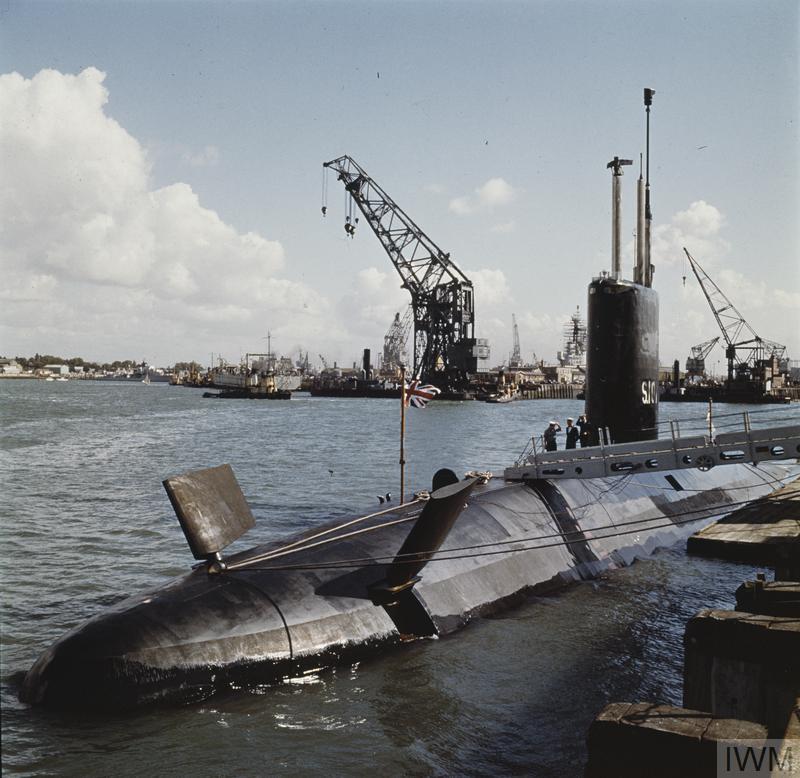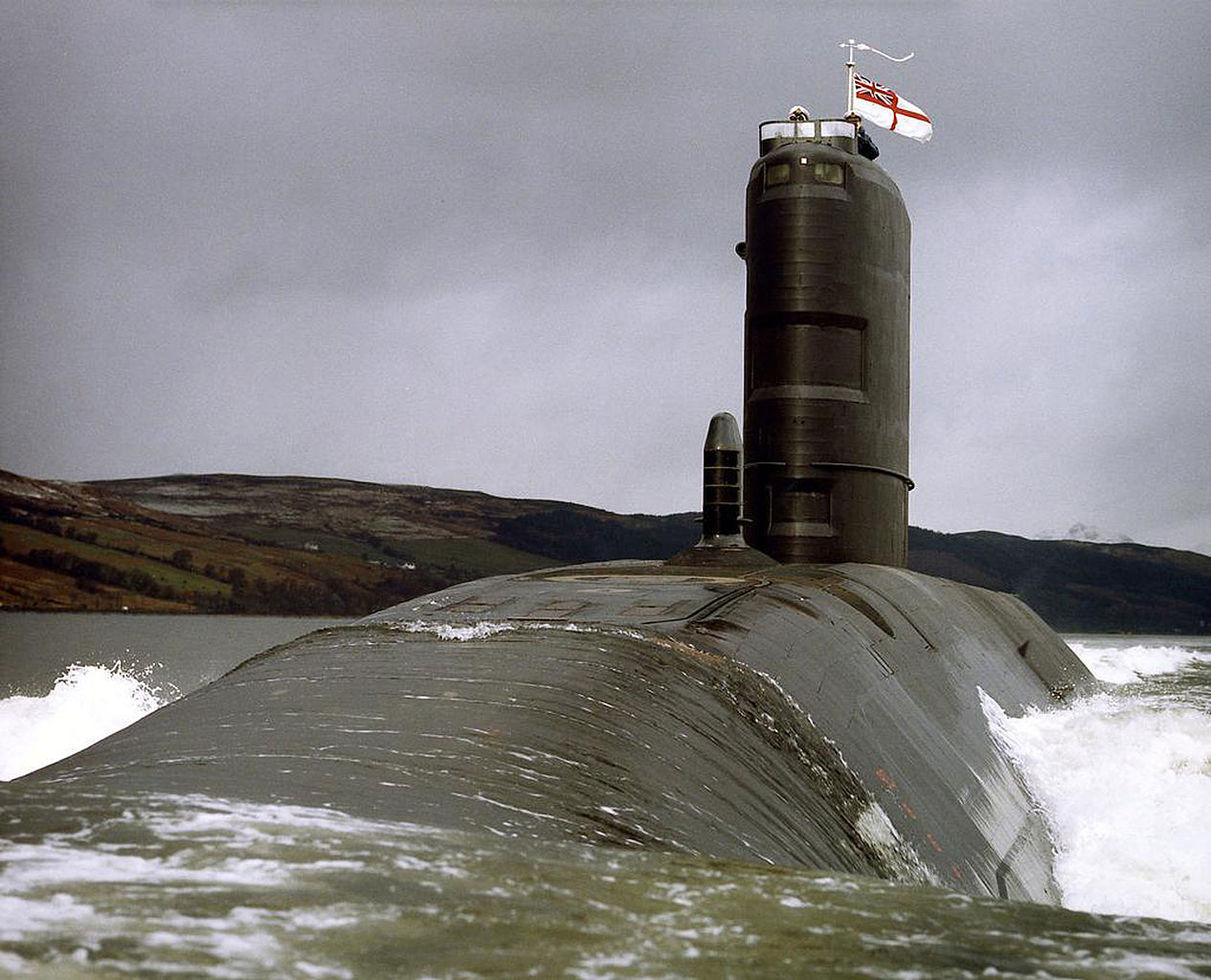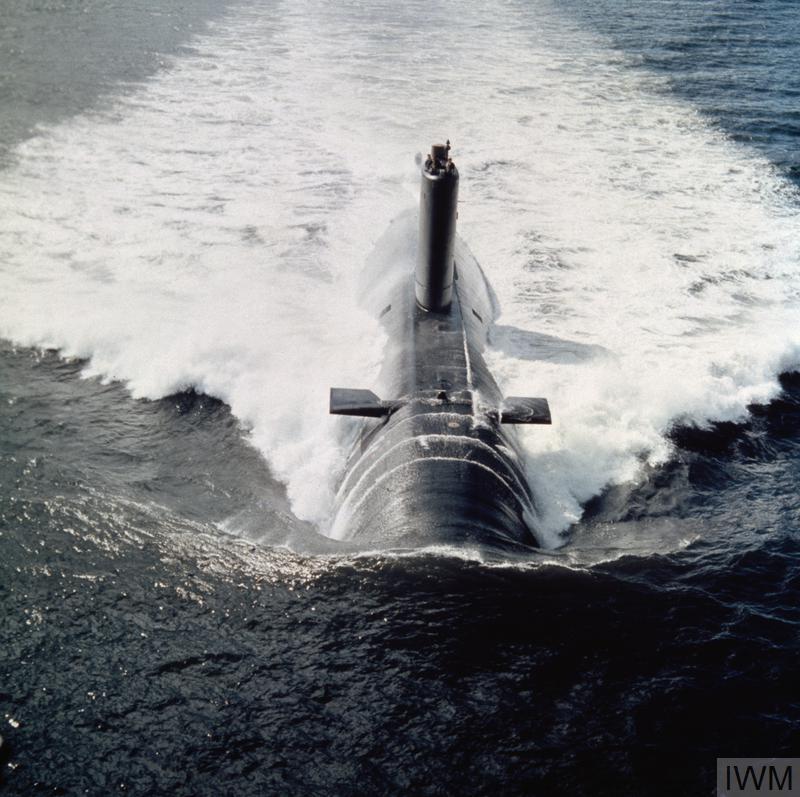When I wrote my series on the Falklands War, there was one major gap in my account. At the time, I had very little information on the exploits of the British submarines during the war, with one notable exception. But I've since acquired new sources, which shed light on this aspect of the conflict.

HMS Dreadnought in earlier days
The story actually begins five years before the outbreak of war. In 1977, Britain and Argentina began negotiations over the future of the Falklands, and Argentina's hard-line position concerned the British enough that they began to worry about an invasion. That November, a naval force was dispatched to the South Atlantic, with frigates Phoebe and Alacrity, auxiliaries Olwen, Cherryleaf and Resurgent and HMS Dreadnought, Britain's first nuclear submarine. Dreadnought, underway for a deployment to Australia, was diverted to Gibraltar and prepared for war, including loading extra food and removing bunks to hold more torpedoes. So much equipment was taken on board that it was discovered she was too heavy to be neutrally buoyant at periscope depth.1 Dreadnought was dispatched to the seaward approaches to the Falklands, and her orders are a matter of dispute, with some claiming that in the event of Argentine aggression, she was to expose herself to make the implied threat clear, or even had carte blanche to shoot if they moved within range of the islands. She was never detected by the Argentinians,2 but it seems likely that her presence was quietly revealed to their government by the British in an attempt to deter them from taking action. The rest of the force, with the exception of Cherryleaf, remained well to the north of the islands, and returned home in early 1978 as the crisis abated. One of the biggest results was the patrol report Dreadnought brought home, which proved invaluable four years later when the RN again had to operate in the little-known waters of the South Atlantic.
As tensions increased in March of 1982, Argentina cast a wary eye on Britain's SSN force in case of a repeat of Dreadnought's voyage. When HMS Superb sailed from Gibraltar on March 26th, some thought she was headed for the South Atlantic, although she was actually tasked with one of the routine but vital Cold War patrols against Soviet submarines in the North Atlantic. Three days later, it was clear that the situation was getting much worse, and two other SSNs were recalled from patrols to load weapons and supplies for the South Atlantic: Spartan, off Gibraltar, and Splendid, in the Western Approaches. They left on April 1st and 2nd respectively, beginning the two-week high-speed runs that would carry them to the vicinity of the Falklands. It was here that the strategic mobility of the nuclear submarine really shown, as each boat was able to maintain 28 kts or more for the entire time, a capability matched by few other vessels. A third submarine was identified but not dispatched, as the UK had only six or seven operational SSNs and couldn't spare more from their duties in the undersea war with the Soviets. But things in the South Atlantic were moving too fast even for nuclear power, and even as Splendid prepared to dive off Faslane, the BBC broadcast the news that Argentina had invaded the Falklands.

HMS Splendid
The third submarine, HMS Conqueror, was ordered to prepare for a deployment to the South Atlantic, including loading a team from the Special Boat Service and nine tons of their gear. However, the Navy believed that using its SSNs for special operations support would be too much of a distraction from their main mission of sea control and made plans to deploy one of its Oberon class diesel submarines to do the job instead, eventually choosing HMS Onyx. The SSN-special forces partnership would end when Conqueror transferred her passengers to Antrim by helicopter in the rough waters off South Georgia, nearly losing two of the men over the side.
The plan for the SSNs was that three of them would cover the main bases of the Argentine navy, ready to respond to any breakout, while a fourth stayed in reserve, ready to deal with any breakthroughs. This would mean another boat heading south, and Valiant, the first all-British SSN, was chosen. She was in the mid-Atlantic on receiving orders, and only low food stores stopped her from turning south immediately. The boats would be commanded from Northwood, operating under separate orders from Sandy Woodward's surface task force. Woodward, a submariner himself, protested this arrangement, but the communication difficulties he faced meant that it was probably for the best. The British also had to figure out the Rules of Engagement the submarines would operate under once they arrived, a tricky matter at the best of times. Defense Secretary John Nott proposed that Spartan be ordered to sink an Argentine ship as soon as possible upon arrival off the Falklands, but this was seen as too radical and a 200-mile Exclusion Zone was declared instead, with submarines authorized to attack identified warships and auxiliaries inside it. The requirement for identification was easy enough when attacking surface ships, but a serious potential problem for anti-submarine work, particularly against the Type 209s Argentina operated. They could be told from SSNs reasonably well, but there was no way to make sure that they were the right diesel boat. Eventually, this problem was solved by telling everyone else to keep their submarines far away from the Falklands.3 Making the ROE problem worse, just as Spartan and Splendid approached the Falklands, American Secretary of State Alexander Haig persuaded the British to suspend the exclusion zone for fear of disrupting negotiations, earning him the ire of the submariners.

HMS Conqueror
Another issue the British faced was lack of information on their enemy. The RN had spent the past decade focused almost exclusively on war with the Soviets, and the best available information on the Argentinian Navy was found in Jane's Fighting Ships. A bit more trickled in via satellite link as the boats sped south, but one of the major lessons of the war was that future conflicts might not be against the Soviets or their clients, and western intelligence agencies needed to pay attention to systems from notionally friendly countries as well as their enemies.
Spartan finally arrived off the Falklands on April 12th, the first British vessel to reach the war zone.4 She and the other submarines would hold the line until the Task Force arrived two weeks later, and blunt the surface threat, a process we will look at next time.
1 Because of how a submarine's ballast system works, it's not always possible to trim to arbitrary weights. Dreadnought was still able to surface. ⇑
2 Interestingly, she was detected by RFA Cherryleaf while doing a covert surveillance exercise. Some lookouts saw her periscope, and she later got a message asking if that was her, which sobered the crew. ⇑
3 This wasn't an idle worry. Shortly after the invasion, the Argentine press reported an SSN detected 250 miles off the coast. The British didn't have a boat in the area, but a British officer that same day heard a Soviet counterpart ask in passing "Are our submarines being of any help?" ⇑
4 Endurance, the ice patrol ship, was already there at the start of the war, thus didn't really reach it. ⇑

Comments
Was this the first actual use of nuclear submarines in combat?
Is there any logic whatsoever to Haig's request? It seems to me like giving up all your bargaining chips "so that negotiations can happen" is just a fast way to lose at the bargaining table.
@echo
Pretty much. Conqueror remains the only SSN to have ever sunk an enemy warship.
@Alsadius
A little bit. If the British had started shooting, then they would actually have been at war, whereas Haig thought there was still a chance for a negotiated solution. I don't think it was a good idea, but it wasn't completely stupid.
In the third paragraph from the end, HMS Valiant is described as "the first British SSN." Typo, or was HMS Dreadnought not considered an SSN? (And the obvious follow-up: if not an SSN, what was she classified as?)
That should read "the first all-British SSN". Dreadnought was a British front section welded to the back half of an American Skipjack. There was a notable difference in hull diameter between the two, and it reportedly made a gurgling sound at high speed.
That's what I expected, but I thought there might be an outside chance that Dreadnought was considered a developmental or experimental boat rather than an attack sub.
The Argentine carrier and newest destroyers were originally-British types, but I don't know how relevant the original plans would be given what had changed since.
Previous discussion of why you might not actually want to do that.
Typo in paragraph 2: "presence as" should be "presence was." Also, the "next time" at the end of the last paragraph isn't linked to the next post.
(Feel free just to delete this comment after fixing the typos.)
I do the "next time" links during yearly overhauls, and this one isn't due until October.
"Because of how a submarine’s ballast system works, it’s not always possible to trim to arbitrary weights. Dreadnought was still able to surface" -- whaaaa?
I thought any balast tank could be filled to any level. Are there tanks where intermediate levels are not possible? And if so, why would anyone want that??
Yes, most ballast tanks on a submarine can only be completely full or completely empty. And because it avoids catastrophic stability problems thanks to free surface effect. Basically, if you have a big tank that's partially filled with water, the water will tend to settle on the low point of the tank, and that makes that part go lower. For submarines, this tends to manifest as catastropic longitudinal instability. So practical submarines tend to use big tanks that are either full or empty, and smaller compensating tanks that are sized and positioned so that they don't destroy stability and which are used to trim the boat. This was one of Holland's key innovations. What happened here was that Dreadnought was loaded to the point that she was slightly heavy even with empty compensating tanks. Note that actual neutral buoyancy isn't normally what submarines aim for, so this wasn't a huge deal.
(I will probably return to this as a filler post. There's interesting stuff here, and I think I can write it up quickly.)
I would think another part of it is that partially full tanks end up creating very bad transients in ballast unless they're re-opened at exactly the same depth as they were closed. The air at the top is either at too high a pressure (in which case the tank will empty) or the air is at too low a pressure (in which case it will flood). With full tanks the water is ~incompressible, and with an empty tank you can use run air pressure over ambient and let the excess vent.
Actually, it's not just that. Main ballast tanks are (almost?) universally outside the pressure hull, because they need quite a bit of volume and pressure hulls are heavy. Which in turn means they can't be sealed at depth, so you'd see the submarine get heavier as it dives, and lighter as it ascends, neither of which are good for being able to hold depth.
Good afternoon. Maybe its me (getting old now !!) but I cannot find HMS Courageous on this article. I have medals on my desk as I type one of which is a South Atlantic Medal. I was the "Wrecker" on board for this conflict. Maybe we were never there when we were dipped by a helicopter ? Or I never witnessed a 209 surface just next to us and we took photos !!! Look forward to a chat if possible please. Mobile 07796968615 Many thanks